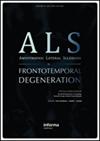The rise of innovative clinical trial designs: what’s in it for amyotrophic lateral sclerosis?
IF 2.5
4区 医学
Q2 CLINICAL NEUROLOGY
Amyotrophic Lateral Sclerosis and Frontotemporal Degeneration
Pub Date : 2020-01-02
DOI:10.1080/21678421.2019.1681455
引用次数: 1
Abstract
The randomized, placebo-controlled trial (RCT) has long been recognized as the gold standard for assessing therapeutic benefit. The randomization ensures that both the observed and unobserved prognostic variables are balanced across treatment arms. Many regulatory agencies require, therefore, RCTs to obtain an unbiased estimate of a drug’s risk–benefit ratio. The conduct of a RCT demands, however, a considerable amount of resources and time. The median costs of phase II and III clinical trials are $8.6 million and $21.4 million, respectively (1); costs that are likely to further increase in the near future (2). These excessive expenditures are especially problematic for rare diseases such as amyotrophic lateral sclerosis (ALS), where funding, awareness and resources could be limited. Therefore, there is a need to improve the efficiency of clinical trial design while maintaining scientific rigor. In this issue of the Journal, Babu et al. (3) deviate from the classical two-armed RCT by applying a ranking and selection paradigm in order to determine which of three treatment strategies (i.e., creatine, tamoxifen 40mg or tamoxifen 80mg) is the most promising for a future pivotal trial. Notwithstanding the recent advancements in preclinical and early clinical models, phase II clinical trials are often the first opportunity for investigators to obtain a hint of therapeutic benefit. Improving the phase II selection process of promising ALS drugs is, therefore, essential, especially when one considers the expanding pipeline of ALS compounds (4). The selection paradigm as proposed by Babu et al. may give preliminary insights in the efficacy and safety of new drugs. As patients can only be allocated to active arms, enrollment rates could be positively affected. The lack of a concurrent placebo arm is, however, also its major drawback. This diminishes the interpretation of the safety data and may provide insufficient insight in the therapeutic benefit. In the end, this could lead to the erroneous selection of a treatment. Further refinement of the proposed methodology may help to ameliorate these limitations. In the last decades, there has been a steady increase in the use of innovative or adaptive design elements in RCTs (5), deviating from the fixed sample size, fixed eligibility criteria and fixed allocation ratios as seen in classical trial design. Adaptive designs use the accruing information during a RCT to make interim decisions regarding, for example, the continuation of subgroups, the re-estimation of sample sizes or to stop a trial early. These design adaptation may help to improve the efficiency of clinical trials when there is sufficient evidence for either superiority or futility. Especially the futility adaptations could prove value for ALS clinical trials (6). The probability that a compound will successfully pass the different phases of drug development, including regulatory approval, is less than 10% for rare diseases (7). In case of ALS, the success probability is even less than 5%: two FDA approvals (i.e., riluzole and edaravone) out of more than 60 tested compounds. Thus, in order to optimize the use and allocation of resources in ALS, the first selection question may not be “Which compound holds the most promise?”, but should rather be “Which compound holds no promise?”. The latter question is the primary aim of adaptive multi-arm, multi-stage (MAMS) clinical trials.创新临床试验设计的兴起:肌萎缩性侧索硬化症有什么好处?
长期以来,随机、安慰剂对照试验(RCT)一直被认为是评估治疗效果的金标准。随机化确保观察到的和未观察到的预后变量在治疗组之间是平衡的。因此,许多监管机构要求随机对照试验获得对药物风险收益比的无偏估计。然而,进行随机对照试验需要大量的资源和时间。II期和III期临床试验的中位成本分别为860万美元和2140万美元(1);在不久的将来,这些费用可能会进一步增加(2)。这些过度的支出对于像肌萎缩侧索硬化症(ALS)这样的罕见疾病来说尤其有问题,因为资金、意识和资源都可能有限。因此,在保持科学严谨性的同时,需要提高临床试验设计的效率。在这一期的Journal中,Babu等人(3)偏离了经典的双臂随机对照试验,采用了排序和选择范式,以确定三种治疗策略(即肌酸、他莫昔芬40mg或他莫昔芬80mg)中哪一种最有希望用于未来的关键试验。尽管最近在临床前和早期临床模型方面取得了进展,但II期临床试验通常是研究人员获得治疗益处的第一个机会。因此,改善有希望的ALS药物的II期选择过程是至关重要的,特别是当人们考虑到ALS化合物管道的扩大时(4)。Babu等人提出的选择范式可能会对新药的有效性和安全性提供初步的见解。由于患者只能被分配到现役,因此入学率可能会受到积极影响。然而,缺乏同步安慰剂组也是其主要缺点。这削弱了对安全性数据的解释,并可能对治疗益处提供不足的见解。最后,这可能会导致错误的治疗选择。进一步完善所建议的方法可能有助于改善这些限制。在过去的几十年里,在随机对照试验中,创新或适应性设计元素的使用稳步增加(5),偏离了经典试验设计中固定的样本量、固定的资格标准和固定的分配比例。适应性设计利用随机对照试验中累积的信息来做出临时决定,例如,继续进行亚组、重新估计样本量或提前停止试验。当有足够的证据证明其优势或无效时,这些设计调整可能有助于提高临床试验的效率。特别是无效的适应性可以证明ALS临床试验的价值(6)。对于罕见疾病,化合物成功通过药物开发不同阶段(包括监管批准)的概率不到10%(7)。对于ALS,成功概率甚至不到5%:在60多种测试化合物中,FDA批准了两种(即利鲁唑和依达拉曲)。因此,为了优化ALS中资源的使用和分配,第一个选择问题可能不是“哪种化合物最有希望?”,而应该是“哪个化合物没有希望?”后一个问题是适应性多臂、多阶段(MAMS)临床试验的主要目标。
本文章由计算机程序翻译,如有差异,请以英文原文为准。
求助全文
约1分钟内获得全文
求助全文
来源期刊

Amyotrophic Lateral Sclerosis and Frontotemporal Degeneration
CLINICAL NEUROLOGY-
CiteScore
5.40
自引率
10.70%
发文量
64
期刊介绍:
Amyotrophic Lateral Sclerosis and Frontotemporal Degeneration is an exciting new initiative. It represents a timely expansion of the journal Amyotrophic Lateral Sclerosis in response to the clinical, imaging pathological and genetic overlap between ALS and frontotemporal dementia. The expanded journal provides outstanding coverage of research in a wide range of issues related to motor neuron diseases, especially ALS (Lou Gehrig’s disease) and cognitive decline associated with frontotemporal degeneration. The journal also covers related disorders of the neuroaxis when relevant to these core conditions.
 求助内容:
求助内容: 应助结果提醒方式:
应助结果提醒方式:


